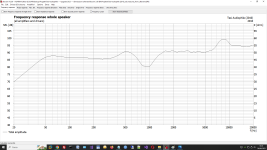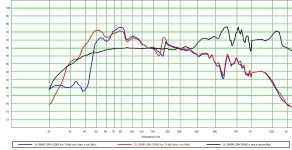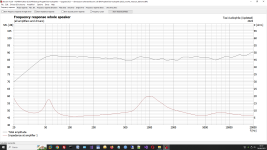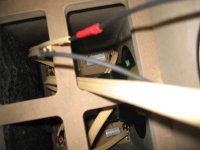Hi,
Today I have used for the first time Room EQ Wizard with my mic behringer ecm8000 to measure my old DIY speakers.
All drivers was measured at only 2 cm from mic.
After these measure I got confirmation that the crossover need an upgrade.
First is clear that the woofer is not 90 dB like the midrange and the tweeter (as usually happens).
There is a strange unstability at 170/200 Hz that happen only if the woofer is inside the box, but is not clear the cause.
The measurements are very different from the simulation (2010) like I expeced but I don't sure how I can interpret these differences.
I have simulated a possible crossover update (2023) with more flat frequency response.
Any suggests ??
Thank you !!
Today I have used for the first time Room EQ Wizard with my mic behringer ecm8000 to measure my old DIY speakers.
All drivers was measured at only 2 cm from mic.
After these measure I got confirmation that the crossover need an upgrade.
First is clear that the woofer is not 90 dB like the midrange and the tweeter (as usually happens).
There is a strange unstability at 170/200 Hz that happen only if the woofer is inside the box, but is not clear the cause.
The measurements are very different from the simulation (2010) like I expeced but I don't sure how I can interpret these differences.
I have simulated a possible crossover update (2023) with more flat frequency response.
Any suggests ??
Thank you !!
Attachments
Some suggestions :
And please share which drivers you are using, and the current crossover schematic.
- Position the speaker as far from room surfaces as possible.
- Measure all drivers with the same mic position and use gating (IR Windows in REW) to avoid early reflections. 6-10 ms will usually work.
- Measure at 1 meter distance. Near-field measurements will get proximity effects and will not capture the effects of baffle diffraction.
- Measure each driver individually. Disconnect the other drivers when measuring one of the drivers.
- Use 1/6 oct smoothing on your measurements.
And please share which drivers you are using, and the current crossover schematic.
2 cm in front of the cone is different than 200 cm. I guess after 20 cm it already starts to be omnidirectional, so it looses some pressure, the one you measuredThere is a strange unstability at 170/200 Hz that happen only if the woofer is inside the box, but is not clear the cause.
it's called baffle step loss
Baffle step does not look like that at all. I guess its a resonance inside the box itself. What kind of stuffing is used inside the box?
Thank you all for your reply, but I think I have found the cause: there is a lack of damping material. What's inside is not enough.
I will add it on the bottom and on the top.
I have already purchased this (sonofil):
https://www.audiokit.it/it/fonoassorbente-fonoassorbente/273201-sonofil-black-fonoassorbente.html
What do you suggest to fix it on top ? on the bottom I think is more complicated.

I will add it on the bottom and on the top.
I have already purchased this (sonofil):
https://www.audiokit.it/it/fonoassorbente-fonoassorbente/273201-sonofil-black-fonoassorbente.html
What do you suggest to fix it on top ? on the bottom I think is more complicated.
Attachments
In Scientology perhaps, but in science? Not so much.Why not? All the radiation scientology talks about that!
A typical baffle step response looks like this:
And not in any way like that :
From your measurements it looks like you have a bass reflex box, so filling the entire volume is not a good idea. However, covering the crossover should not be a problem. Put in at least 5 cm damping on all internal surfaces, and measure again to see if that resonance at 200 Hz is reduced.
I see some (several) errors ( most common) in that inside of the enclosure.
Whos's gonna spot the errors?
Whos's gonna spot the errors?
Hi picowallspeaker,
After ask to other this matherial:
https://www.audiokit.it/it/fonoassorbente-fonoassorbente/273201-sonofil-black-fonoassorbente.html
and they tell me that probably is not enough for this reason I would try to combine other matherial like this:
https://www.monacor.com/products/components/speaker-technology/diy-/mdm-2/
but is not clear to me what glue use to combine the two and fix it to the wood.
I thought of the classic 'Attack' that we have in Italy but I don't sure if is good this this purpose.
After ask to other this matherial:
https://www.audiokit.it/it/fonoassorbente-fonoassorbente/273201-sonofil-black-fonoassorbente.html
and they tell me that probably is not enough for this reason I would try to combine other matherial like this:
https://www.monacor.com/products/components/speaker-technology/diy-/mdm-2/
but is not clear to me what glue use to combine the two and fix it to the wood.
I thought of the classic 'Attack' that we have in Italy but I don't sure if is good this this purpose.
First of all, I'd take all those boards outside. And remove all the plug system, the less contacts, the better
Second, I'd put T-nuts for allowing a tighter hold of the speakers. And remove that foam around the perimeter of the woofer.
Third, yes, put better damping material. Use "mastice" (bostik)
Second, I'd put T-nuts for allowing a tighter hold of the speakers. And remove that foam around the perimeter of the woofer.
Third, yes, put better damping material. Use "mastice" (bostik)
- Home
- Design & Build
- Software Tools
- Speakers measurements with Room EQ Wizard




